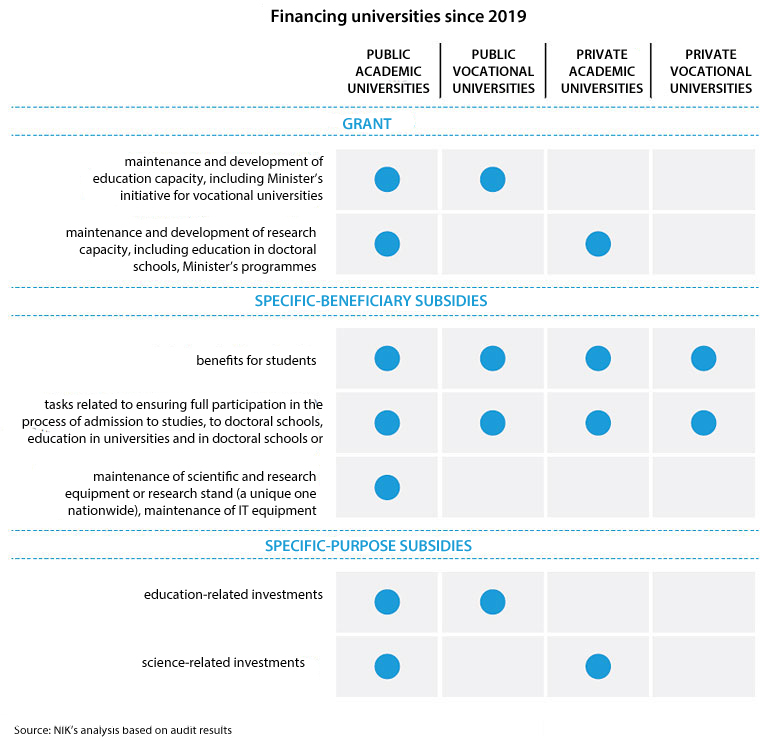At the beginning of school year 2020/2021, in Poland there were 131 active public universities, of which 34 were vocational universities and 97 – academic universities. The majority of universities (93) were supervised by the Minister of Science and Higher Education (now the Minister of Education and Science).

In 2018–2020, the higher education financing system provided universities with conditions which facilitated proper performance of their tasks.
On 1 January 2019, new principles of financing higher education came into force which helped universities maintain their financial stability on the one hand and made them more independent in choosing their development path, on the other.
Changes included, among other things, replacing specific-beneficiary subsidies for educational activity and maintenance of research capacity with a single grant (non-returnable, free and unconditional benefit).

This financing system enabled universities management on a broader scale but at the same time made it difficult for the Minister to control granted funds. The system evaluation – postponed to 2022 – will show consequences of that situation. What we know now is that before implementing the system changes, the Ministry did not make any risk analysis, nor did it specify adequate control mechanisms.
It is also clear that the Minister of Higher Education and Science failed to define strategic objectives of the implemented changes in due time. The reason was that the relevant strategic document - the draft scientific policy of the state – was not passed by the government until 31 March 2020, which was against statutory requirements. According to NIK, there is a risk that the funds granted to universities by the Minister may not be used in line with their purpose.
Under the new law on higher education and science, universities are obliged to devise development strategies and report on their implementation. The audited universities implemented strategies which were developed even before the new law came into force, in line with outdated regulations. Besides, most of those documents were prepared in a way which made it impossible to evaluate the target and task performance levels in an objective way.
The reports were fragmentary and did not refer achieved effects to declared targets and tasks.
Most public universities maintained a positive financial result and, at the same time, found it difficult to absorb granted funds. In 2018-2020 (1st to 3rd quarter), their net profit on operations totalled PLN 622.2 million. According to NIK this is a consequence of the Minister granting additional funds without full analysis of data on the universities’ research and education capacity and their financial standing. That is why, the Minister had no information of how the funds were used. NIK has underlined that it is difficult to take appropriate decisions in this situation.
In 2019-2020, the Minister also increased grants for public academic universities – in 2019 by about PLN 1.4 billion, whereas for public vocational universities by PLN 77.8 million. Ministers supervising other universities (except for 93 ones, supervised by the Minister of Higher Education and Science) also increased grants. Similarly in 2020, grants provided by the Minister were augmented – until November 2020 by over PLN 41 million (of which more than PLN 27 million was related to COVID-19 prevention measures). In three cases of grant increases, it was found that documents were not prepared properly.
In 2019, the Minister improperly expanded grants for four universities by PLN 25 million only as a result of an amendment made by a group of MPs in the course of legislative works on the draft Budget Act for 2019. NIK has stressed that findings of the Sejm Committee of Public Finance are not binding for the administrator of a budget part and that there were no provisions of law defining an obligation to increase grants for those four universities by PLN 25 million.
Apart from specific-beneficiary subsidies for educational activity (PLN 10.3 billion) and grants (PLN 25.2 billion), the Minister allocated also treasury securities to selected public universities (PLN 889.5 million only in 2020). In case of 10 universities the Minister allocated the funds without documented analyses of their needs or financial standing.
Most of the audited universities properly spent public funds received from the Minister based on appropriately prepared material and financial schedules. However, in two universities specific-beneficiary subsidies for disabled students and postgraduates were not used properly.
NIK has positively evaluated the Minister’s initiative and implementation of two programmes addressed to academic universities and one initiative for vocational universities.
Recommendations
to the Minister of Education and Science
- to provide funds to allocate the principal part of subsidies in the amount enabling the use of algorithm, defined in appendices to the Minister’s ordinance on the allocation of grants;
- to define the principal and complementary part of grants addressed to public universities;
- properly increase grants, in line with applicable law;
- allocate treasury securities under documented analyses;
- conduct risk analyses, in case of any significant change having impact on the functioning of entities financed from the budget part administered by the Minister;
- verify data gathered in the IT system on a timely basis;
to rectors of public universities
- to properly prepare university strategies, in a way enabling objective evaluation of their implementation level.


